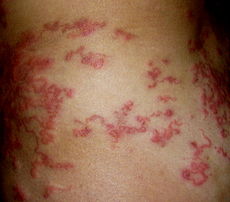- Cutaneous larva migrans
-
Cutaneous larva migrans Classification and external resources 
Typical "creeping eruption" associated with cutaneous larva migransICD-10 B76.9 ICD-9 126.9 DiseasesDB 3263 eMedicine derm/91 ped/1278 MeSH D007815 Cutaneous larva migrans (abbreviated CLM) is a skin disease in humans, caused by the larvae of various nematode parasites of the hookworm family (Ancylostomatidae). The most common species causing this disease in the Americas is Ancylostoma braziliense.
Colloquially called creeping eruption due to the way it looks, the disease is also somewhat ambiguously known as "ground itch" or (in some parts of the Southern USA) "sandworms", as the larvae like to live in sandy soil. Another vernacular name is plumber's itch. The medical term CLM literally means "wandering larvae in the skin".
Contents
Cause
These parasites are found in dog and cat feces and although they are able to infect the deeper tissues of these animals (through to the lungs and then the intestinal tract), in humans they are only able to penetrate the outer layers of the skin and thus create the typical wormlike burrows visible underneath the skin. The parasites apparently lack the collagenase enzymes required to penetrate through the basement membrane deeper into the skin.
Presentation
The infection causes a red, intense itching eruption. The itching can become very painful and if scratched may allow a secondary bacterial infection to develop. The itching will stop after the parasites are dead.
Treatment
CLM can be treated in a number of different ways:
- Systemic (oral) agents include albendazole (trade name Albenza) and ivermectin (trade name Stromectol).
- Another agent which can be applied either topically or taken by mouth is thiabendazole (trade name Mintezol), an anti-helminthic. When taken orally, this medication is known to cause nausea. A topical preparation can be made by mixing the ground pills in vaseline. This mixture can be spread lightly on the lesion and held in place with a plaster. This produces local tissue levels sufficient to kill the parasite without the systemic side effects when taken orally.
- Topical freezing agents, such as ethyl chloride or liquid nitrogen, applied locally can freeze and kill the larvae (but is often a hit-or-miss proposition).
- It is recommended to use Benadryl or some anti-itch cream (i.e. Cortizone or Calamine lotion). This will help relieve some of the itch.
See also
Additional images


External links
Categories:- Parasitic infestations, stings, and bites of the skin
- Helminthiases
- Zoonoses
Wikimedia Foundation. 2010.
